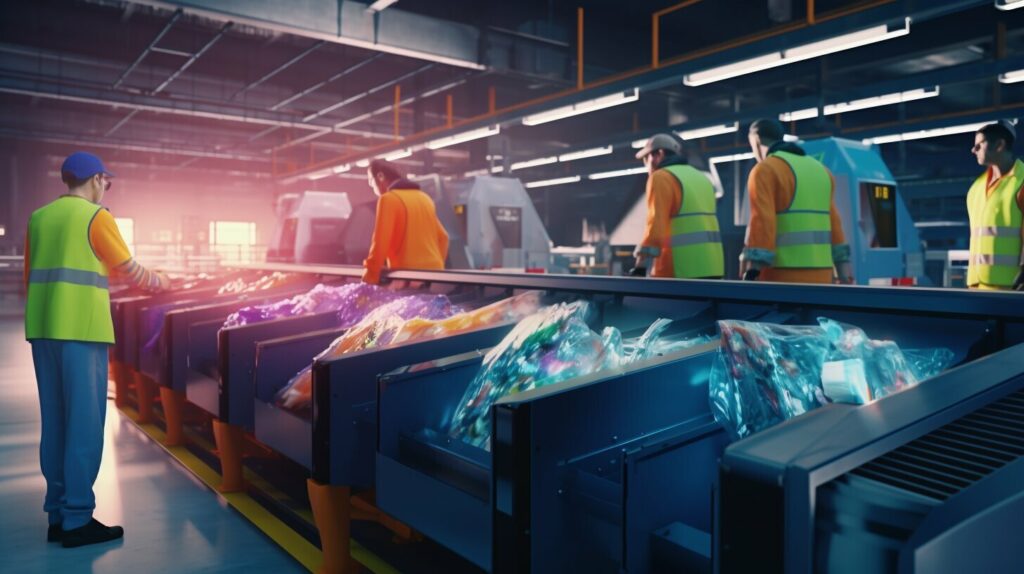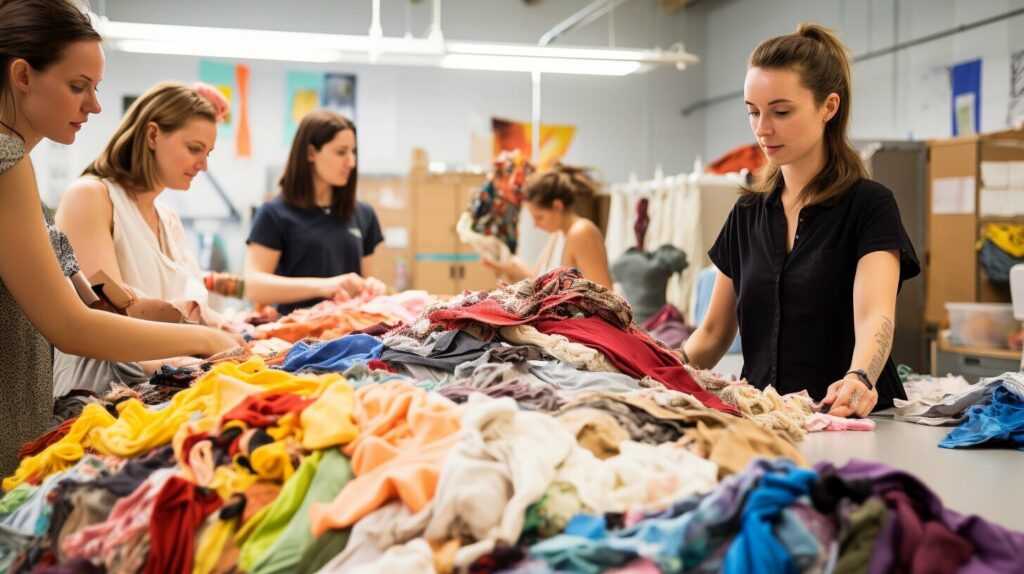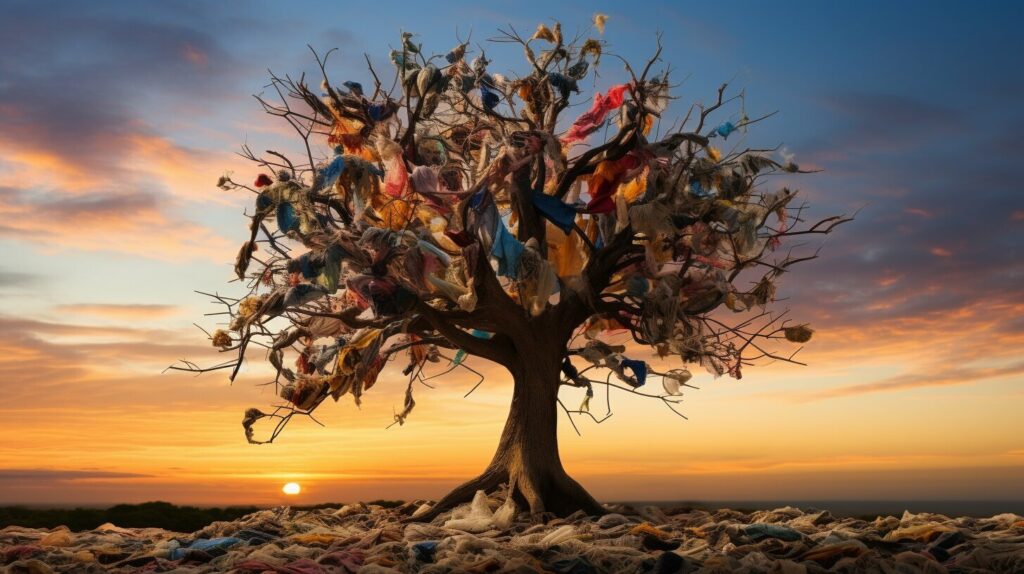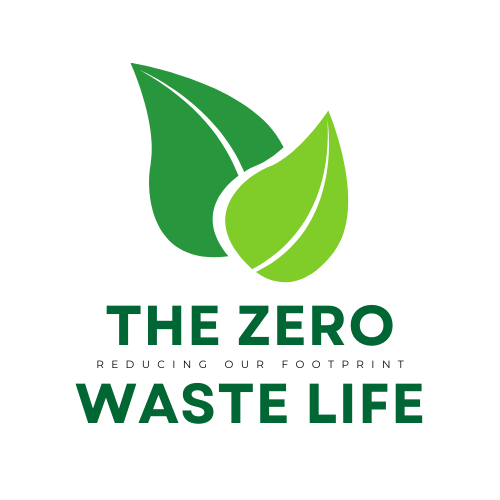As a professional copywriting journalist, I believe it is essential to shed light on the importance of textile recycling in creating a sustainable future for the fashion industry. The staggering amount of textile waste generated each year presents an urgent need for effective waste management solutions, and sustainable textile recycling offers a promising approach to mitigate the negative environmental impact.
With the rising demand for fast fashion and disposable clothing, the fashion industry has become one of the largest polluting industries globally. The good news is that textile recycling presents an opportunity to reduce waste and promote circular economy practices. Recycling textiles not only saves natural resources, but it also reduces energy consumption and water usage, and minimizes greenhouse gas emissions.
Key Takeaways:
- Textile recycling is crucial in creating a sustainable future for the fashion industry
- Sustainable textile recycling helps reduce environmental impact
- Recycling textiles saves natural resources and minimizes greenhouse gas emissions
Understanding Textile Waste: Challenges and Opportunities
As I mentioned in the previous section, textile waste is a major environmental problem. The fashion industry generates massive amounts of waste through discarded clothing and textile scraps, which end up in landfills and contribute to pollution and greenhouse gas emissions. Disposing of textile waste is challenging because it often contains synthetic fibers that do not biodegrade easily.
However, there are opportunities to turn textile waste into new products through textile recycling. The recycling process can transform used clothing and textile scraps into new raw materials, reducing the need for virgin resources. This circular approach minimizes waste and improves resource efficiency in the fashion industry.
Understanding Textile Waste Disposal
When discussing textile waste, it’s essential to understand the impact it has on the environment. Textile waste that ends up in landfills can release harmful chemicals and greenhouse gases into the air and soil. Additionally, textile production is resource-intensive, requiring large amounts of water, energy, and chemicals. Therefore, reducing textile waste through sustainable textile recycling is crucial in creating a more sustainable future for the fashion industry.
| Environmental Impact of Textile Waste | Opportunities for Textile Recycling |
|---|---|
| – Releases harmful chemicals and greenhouse gases when decomposing in landfills | – Transforms used clothing and textile scraps into new raw materials |
| – Resource-intensive textile production requires large amounts of water, energy, and chemicals | – Reduces the need for virgin resources |
These challenges and opportunities make it clear that textile recycling is a crucial aspect of sustainable textile waste management. By recycling textiles, we can reduce pollution, conserve resources, and create a more circular and sustainable fashion industry.

“The recycling process can transform used clothing and textile scraps into new raw materials, reducing the need for virgin resources.”
Environmental Benefits of Textile Recycling
Textile recycling offers numerous environmental benefits and is crucial in reducing the impact of the fashion industry on the environment. By reusing and repurposing textile waste, the amount of water and energy required for production is significantly reduced, as well as the amount of greenhouse gas emissions produced.
According to the Waste and Resources Action Programme (WRAP), the level of carbon dioxide emissions from recycled textiles is around 3.4kg CO2 per kg of recycled textiles, while the emissions from landfill disposal are around 7.2 kg CO2 per kg of textiles sent to landfill.1
Textile recycling centers play a critical role in efficiently collecting and processing textile waste. These centers help to prevent waste from ending up in landfills, where it decomposes and produces harmful greenhouse gases that contribute to climate change. Instead, the waste is sorted and processed, ensuring that it is reused or recycled in an environmentally friendly way.

Additionally, the demand for virgin raw materials, such as cotton and polyester, is reduced through textile recycling. This means that there is less pressure on natural resources, resulting in a more sustainable future for the fashion industry.
By embracing sustainable textile recycling practices, we can significantly reduce the impact of the fashion industry on the environment and ensure a more sustainable future for generations to come.
The Economics of Textile Recycling
As the textile recycling industry continues to grow, it presents a range of economic benefits, including job creation and market opportunities for companies involved in sustainable textile recycling.
According to a report by the Ellen MacArthur Foundation, transitioning to a circular economy approach in the global textile industry could create $560 billion in economic opportunity annually by 2030. This approach would involve recycling and repurposing textiles, extending their lifespan and reducing waste.
The growth of textile recycling companies also presents a promising economic outlook. For example, the U.S.-based textile recycling company, Fabscrap, has seen significant growth since its inception in 2016, doubling its revenue each year and employing over 30 people.
| Market Opportunities for Textile Recycling Companies | Financial Benefits for Investors |
|---|---|
|
|
In addition to the economic benefits, investing in sustainable textile recycling aligns with the growing demand for environmentally responsible practices in the fashion industry. By closing the loop on textile waste and promoting circular economy principles, the industry can reduce its overall environmental impact and contribute to a more sustainable future.
Innovative Technologies in Textile Recycling
As the demand for sustainable textile production increases, innovative technologies are being developed to transform textile waste into new raw materials. Mechanical and chemical processes are being utilized to break down fabrics into their original fibers, which can then be used to create new products.
One such technology is chemical recycling, which involves breaking down textile waste using chemicals to create a solution of new fibers that can be spun into new fabrics without losing any quality. This method is particularly useful for blended fabrics that are difficult to recycle mechanically.
| Technology | Description |
|---|---|
| Mechanical Recycling | Involves breaking down fabrics into individual fibers, which can be spun into new yarns and fabrics. |
| Chemical Recycling | Uses chemicals to break down textile waste into solutions of new fibers that can be spun into new fabrics without any loss of quality. |
Sustainable textile recycling practices are also being developed to complement these technologies. Zero-waste manufacturing, for example, involves designing products with the intention of using all material generated in the production process. This practice not only reduces textile waste but also lowers production costs.

The use of innovative technologies in textile recycling has the potential to significantly reduce textile waste and promote a circular economy in the fashion industry. However, it is important to ensure that these technologies are sustainable and do not create additional environmental problems.
Collaboration and Education: Driving Textile Recycling Initiatives
As I mentioned earlier, collaboration between fashion brands, consumers, and recycling organizations is crucial for promoting and driving textile recycling initiatives. The fashion industry needs to work together to create a culture of sustainability and reduce textile waste.
One example of successful collaboration is the partnership between H&M and the Hong Kong Research Institute of Textiles and Apparel (HKRITA). Together, they developed a hydrothermal textile recycling process that can transform old cotton and polyester clothes into new fibers without using any chemicals. This shows that when fashion brands and recycling organizations work together, they can create innovative solutions for reducing textile waste.
Education also plays a significant role in driving textile recycling initiatives. Consumers need to understand the importance of textile recycling and how they can participate in clothing recycling. Brands can educate their customers on how to recycle their clothes properly and encourage them to donate old clothes to recycling organizations. Recycling organizations can also educate the public on the benefits of textile recycling and how it can reduce environmental impact.
By working together and educating the public, we can create a sustainable future for the fashion industry through textile recycling. Let’s join forces and make a difference!

Textile Recycling in Action: Successful Case Studies
Let me share with you some of the successful case studies of textile recycling that have made a positive impact on reducing textile waste and promoting sustainable practices.
Patagonia’s Common Threads Initiative: Patagonia is a well-known outdoor clothing company that launched its Common Threads Initiative in 2005. The initiative encourages customers to recycle their old clothes by bringing them to Patagonia stores or sending them back by mail. The company then either repurposes the clothes or recycles them into new garments. Patagonia’s initiative shows how a well-known brand can make a significant impact on reducing textile waste.
Circular Systems: Circular Systems is a sustainable textile recycling company that has developed technology to transform textile waste into new raw materials. Their technology includes the Agraloop BioFibre, which turns food-crop waste into natural fibers, and Texloop, which upcycles post-consumer textile waste into new yarns. The company collaborates with fashion brands to reduce textile waste and promote sustainable practices.
These case studies demonstrate the positive impact of textile recycling and the potential for collaboration between fashion brands and recycling companies. By promoting textile recycling initiatives, we can reduce textile waste and create a sustainable future for the fashion industry.
Future Trends in Textile Recycling
As the fashion industry continues to prioritize sustainability, there are several exciting trends emerging in textile recycling. One major trend is the development of new and innovative recycling technologies, such as mechanical and chemical processes, which allow for the transformation of textile waste into new raw materials. These cutting-edge solutions offer a promising path forward for reducing the industry’s environmental impact and promoting circularity.
Another trend is the growing awareness and demand for sustainable products among consumers. As more people become conscious of the impact of their purchases, they are seeking out products that align with their values. This shift in consumer behavior is driving fashion brands to prioritize sustainable practices, including textile recycling, in order to remain competitive in the marketplace.

Regulatory support is also playing a role in driving the adoption of textile recycling. Governments around the world are recognizing the need for more sustainable practices in the fashion industry and are implementing policies to incentivize companies to reduce waste and promote circularity. These policies are creating a more favorable environment for textile recycling companies and spurring the growth of the industry.
The future of textile recycling looks promising, but it also relies on continued collaboration and education. Brands, consumers, and recycling organizations must work together to establish effective waste management systems and promote sustainable practices. By making a conscious effort to reduce textile waste and create a circular economy, we can pave the way for a more sustainable future for fashion and fabrics.
Conclusion
In conclusion, textile recycling is a crucial step towards creating a sustainable future for the fashion industry. As we have seen, effective textile waste management is necessary to reduce the environmental impact of the industry. Sustainable textile recycling plays a vital role in this process by transforming textile waste into new products and reducing the need for virgin resources.
It’s essential to understand the challenges associated with textile waste disposal and the positive impact of recycling on the environment. By reducing water usage, energy consumption, and greenhouse gas emissions, textile recycling has many environmental benefits.
Moreover, the economics of textile recycling are also important to consider. As the industry continues to grow, it presents significant market opportunities and potential for job creation. Investing in textile recycling can have financial benefits while contributing to a sustainable future.
Innovative technologies in textile recycling, such as mechanical and chemical processes, are transforming textile waste into new raw materials, and sustainable textile recycling practices are vital in this technological advancement. Collaboration between fashion brands, consumers, and recycling organizations is crucial to driving textile recycling initiatives, and education plays a vital role in raising awareness and encouraging participation.
We have seen successful case studies of textile recycling projects that have had a positive impact on reducing textile waste and promoting sustainable practices. These collaborations between fashion brands and recycling companies are a stepping stone towards a more circular economy approach in the textile industry.
In the future, we can expect advancements in recycling technologies, increased consumer awareness and demand for sustainable products, and regulatory support that can further promote sustainable textile recycling practices.
Join me in taking action towards a sustainable future by supporting textile recycling initiatives and incorporating sustainable practices into our everyday lives. Together, we can minimize the environmental impact of the fashion industry and make a positive impact on the planet.

